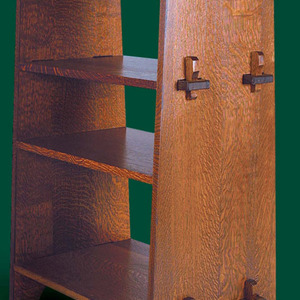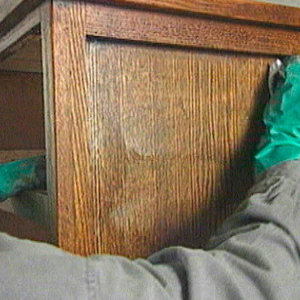How to Fume Furniture with Ammonia
Watch a demonstration of this classic Arts and Crafts finishing techniqueIn this video, woodworker and Fine Woodworking associate art director Kelly Dunton demonstrates how to stain a white oak table by exposing it to ammonia fumes. Unlike most finishing techniques, ammonia fumes react chemically with tannins in the wood causing it to permanently change color. The technique was popularized by Gustav Stickley and other Arts and Crafts furniture makers of his era.
Safety First
The ammonium hydroxide used for fuming contains around 28% ammonia compared to less than 5% in household ammonia. You should take extra precautions when handling this material, also known as aqua (or aqueous) ammonia. Avoid eye or skin contact with the ammonia by using goggles or a full-face shield, and protective gloves. A respirator with cartridges designed for ammonia is ideal, but basic charcoal vapor filters will reduce the exposure. If you don’t have a respirator, use a fan and stay upwind of the fumes.
Use a glass or plastic container rather than a metal one to hold the ammonia while fuming. Make sure that you don’t use an aluminum pie plate because the ammonia will dissolve it. After you have finished fuming, dispose of the used ammonia in a large bucket of water, which can then be poured on the ground or on the compost heap. It makes a good fertilizer.
Where to find ammonia
If you can find this type of ammonia locally, you will save yourself a large fee for shipping and handling this hazardous material. This type of ammonia is used in the manufacture of large blueprints, so possible sources include office-supply stores. Last we checked, you can purchase it online at www.hvchemical.com for just under $14 a gallon, but the shipping will cost you $39.






















Comments
I have to take exception to your safety procedures shown here. Yes you're outdoors and the fan blow away the fumes, but "should" is never good enough. What if you knock over the jug and spill ammonia all over the place? What if somebody walks past the other side of the door, trips on the fan cord and unplugs it--just as you're pouring the ammonia into the tray? Will you bet your health, maybe even your life, that something like that won't happen?
When you're working with something as dangerous as 28% ammonia, the bare minimum protection would be a half-face respirator with cartridges rated for ammonia vapor; AND sealed goggles, to protect the eyes. A suitable cartridge would be 3M 60926 P100, which is good against a wide range of harmful vapors; a 2-pack is available on Amazon for about $20. The respirator frame itself costs about the same. The goggles should be about the same amount again. So for $60 you'll be protected--with plenty of life left in the cartridges for future projects.
If you wear glasses, you may need to get a full-face respirator that will fit over them. This costs more--$100-125 including the cartridges. But again, what price would you put on your lungs and your eyesight?
Always remember, safety isn't about what "shouldn't" happen. Safety is about making those things impossible.
I absolutely agree! I’ve fumed over 400 feet of white oak, using anhydrous ammonia and a 3m safety mask as described above. This method came from several articles on fuming.
Trying this project with just a fan will lead to disaster.
I sincerely recommend that fine woodworking remove this article before they get sued and lose!
Anhydrous ammonia is used by blueprint suppliers and when you talk to them, they all recommend masks.
Fuming came about because the early a and c builders used oak from old barns which had been saturated by animal urine, yielding that wonderful aged look.
WITHOUT A NIOSH LEVEL CHEMICAL MASK YOUR ARE IN GRAVE DANGER!!!
Log in or create an account to post a comment.
Sign up Log in